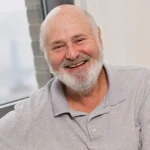
A Missouri man is looking to meet an Ohio stranger he already knows quite a bit about — from getting about as far down and dirty as you can get.
But this is not a saga of looking for love in some tawdry place.
Marc Johnson is a professor of molecular microbiology and immunology at the University of Missouri School of Medicine and has found that someone connected with two Ohio communities has a strain of the coronavirus he has never seen before, according to The Columbus Dispatch.
Beginning with the onset of the COVID-19 pandemic, authorities in many communities began testing sewage to see what kinds of infections had been present. Through those kinds of tests, Johnson has determined there is a person with a unique strain of the virus with a distinct marker that has shown up in sewage from two places — the state capital of Columbus and Washington Court House, Ohio, about an hour’s drive south Columbus.
Johnson began the quest with a public appeal in a Twitter thread in April.
Help me solve a COVID cryptic lineage mystery.
Cryptic lineages are distinct SARS-CoV-2 lineages that we detect in wastewater, but do not know their source. We believe they are from patients with very long COVID infections.
Here is more backstory.https://t.co/n9MdSLnVkI
1/
— Marc Johnson (@SolidEvidence) April 24, 2023
“Help me solve a COVID cryptic lineage mystery,” he wrote. “Cryptic lineages are distinct SARS-CoV-2 lineages that we detect in wastewater, but do not know their source. We believe they are from patients with very long COVID infections …
“We recently discovered a cryptic lineage in Ohio. It appears to be derived from a person that was infected over 2 years ago,” he wrote in another tweet.
John’s best guess is that the person lives in Columbus and routinely travels to Washington Court House, with a population of about 15,000 most likely for work.
Does government possess the power to mandate vaccines?
Yes: 17% (1 Votes)
No: 83% (5 Votes)
“This person was shedding thousands of times more material than a normal person ever would,” Johnson said in a Thursday interview, according to the Dispatch. “I think this person isn’t well. … I’m guessing they have [gastrointestinal] issues.”
In the language of science, the strain is called “cryptic.” It is also one of many that Johnson is tracking, including one in the Bronx section of New York City.
I’ve got another cryptic lineage mystery and this one is really specific (read to the end).
It’s a lineage from the Bronx that have been appearing in Biobot’s sequences off and on since last August. pic.twitter.com/5IpC09VMAd
— Marc Johnson (@SolidEvidence) May 24, 2023
Some mysteries are never solved. Johnson told the Dispatch that one strain of COVID-19 that appeared in Wisconsin for 17 months and had been traced to one specific place suddenly stopped showing up in wastewater.
He explained to WCMH-TV in Columbus how that project worked.
“We started from the main treatment plant of over 100,000 people, and sort of like checked all the lines. And all of them, only one of the lines had the lineage. And so we would just keep going — checking… all of the pieces of the web, figuring out– following it up, up the line until we got to a single manhole. That manhole actually only got waste from one place, which was a company (that) had about 30 employees,” he said.
The company offered free testing to its employees, the Dispatch reported, but all tests came back negative.
“We don’t know if that person quit (their job at the company) or got better,” he said.
As to the Ohio strain, he wrote in the Twitter thread that one infected individual is “the most likely explanation.”
The lineage in just two sewersheds. The sequence drifts over time, but the sequence in the two sewersheds drift together. If it were multiple people the sequence would form distinct branches. We don’t have proof it’s one person, but it is the most likely explanation.
— Marc Johnson (@SolidEvidence) June 7, 2023
A statement from the federal Centers for Disease Control and Prevention to the Columbus Dispatch said the strain Johnson found “is not currently spreading or a public health threat,” according to the newspaper.
“Unusual or ‘cryptic’ sequences identified in wastewater may represent viruses that can replicate in particular individuals, but not in the general population. This can be because of a compromised immune system. CDC and other institutions conduct studies in immunocompromised individuals to understand persistent infection and virus evolution,” the statement said.
Johnson told WCMH-TV that he analyzes the genetic material of the virus, which identifies which strains are where. Variants such as omicron or delta are well known, but there are also ones known as cryptics.
“(Cryptics) have certain patterns; there are certain mutations that they regularly accumulate that are not in circulating lineages,” Johnson said.
In his Twitter post, he wrote that the cooperation of the person suspected to be infected would be needed to obtain the necessary information.
If you know anyone that might be the source based on where they live and work, ask them to do this. The next time they go to the bathroom (#2), stick the swab from a COVID rapid antigen test into the dirty water and test it like normal.
I’d love to know if it is positive.
6/
— Marc Johnson (@SolidEvidence) April 24, 2023
He said studying this individual could provide important information about the virus.
9. There is no ‘manhunt’ to track this lineage through wastewater, but it would not be hard at all given the massive amount that is shed.
The question is whether that is the correct thing to do.
I think it is, but this decision can only be made by public health officials.
— Marc Johnson (@SolidEvidence) June 8, 2023
“How many cases are there like this? What are their symptoms? Does this– is this related to long COVID?” Johnson said, according to WCMH.
“There are a lot of people who got COVID and never really got over it, and we don’t know why. It’s probable most of them are not chronic infections, but some of them might be, which would actually be good, because that’s theoretically treatable, and they actually get better,” he said








